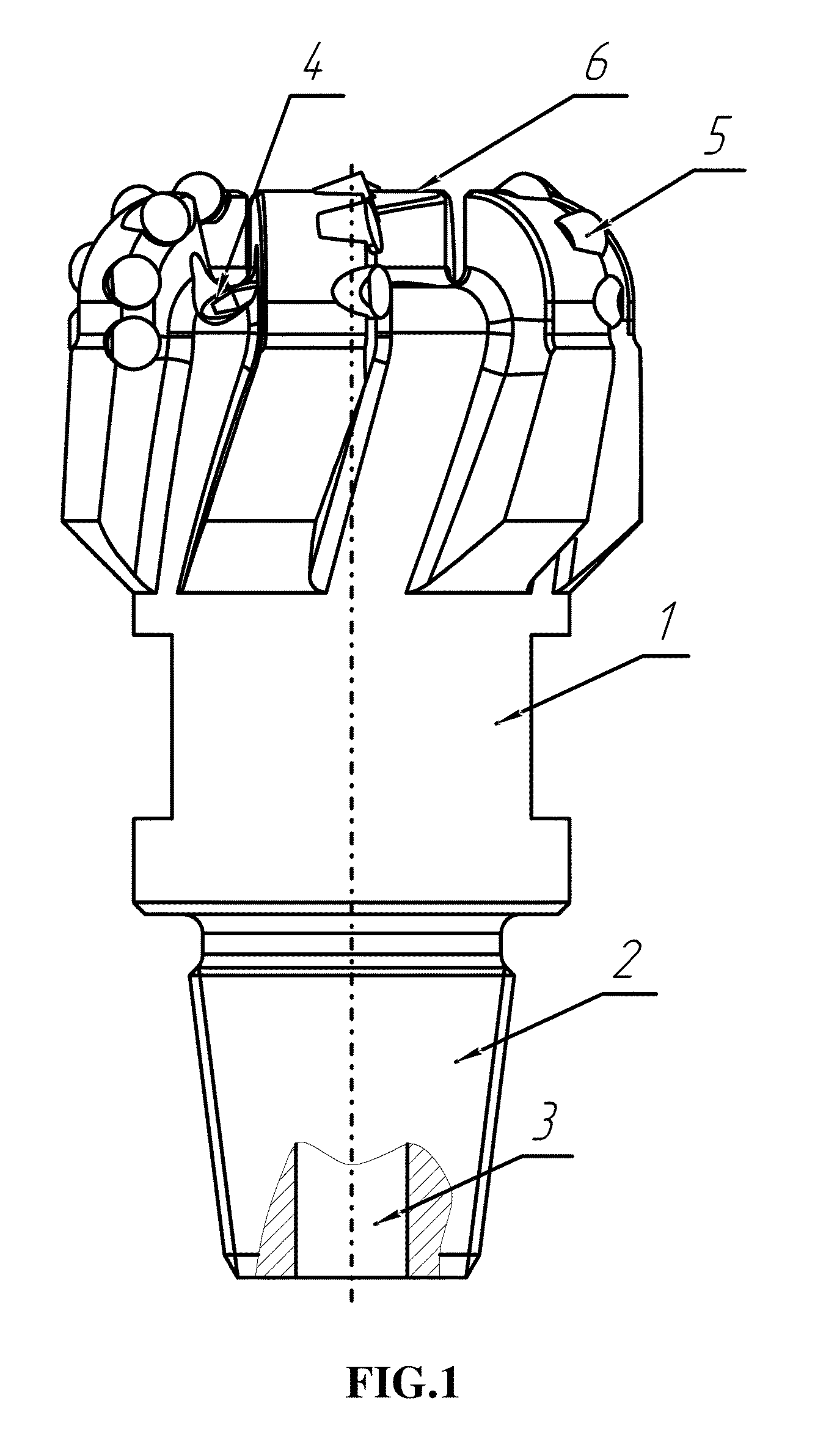Blade-type drill bit
a drill bit and blade-type technology, applied in the field of rock destructing tools, can solve the problems of increasing the weight of drill string, affecting the stability of drilling, and affecting the performance of drilling bit, etc., to achieve optimal rop and steerability of pdc bit, facilitate formation of additional stabilization channels, and reduce the effect of excessive penetration
- Summary
- Abstract
- Description
- Claims
- Application Information
AI Technical Summary
Benefits of technology
Problems solved by technology
Method used
Image
Examples
example 1
[0035]Six-bladed drill bit BIT 220.7 BT 613 (type IADC S333) for drilling soft sandstones and clays was used in the tests. These formations typically have strength varying from 4 to 6 kg / mm2 in the upper interval of the formation and 15-20 kg / mm2 in the lower interval of the drilled formation. The friction angle of these formations usually varies from 44 to 42 in the upper interval and 34 to 36 in the lower interval of the drilled section respectively. The drill bit 220.7 BT 613 is normally used at an average drilling rate from 50 to 70 m / h. The equivalent thrust load required to obtain the said drilling rate at a rotational speed of 280 to 300 rpm, was usually from 5 to 8 t.
[0036]The drilling bit blades were coated by a composite coating of hard alloy according to the invention to obtain the final thickness of about h=3 mm. Hard alloy coating was applied by means of lamination layer by layer by gas-flame spraying of a composite powder material produced by, for example, Technicord, ...
example 2
[0040]According to Example 2, a four-bladed matrix-type drill bit 220.7 BT 416 M (type IADC M333) for drilling soft sandstone and clay was used.
[0041]The drilling bit was used to drill a formation having strength varying from 3 to 5 kg / mm2 in the upper interval and from 12 to 18 kg / mm2 in the lower interval of the drilled section. The friction angle of the formation was from 46-45 in the upper interval and 32-34 in the lower interval of the drilled section respectively. The drill bit of this type is typically designed to achieve average drilling rate from 50 to 70 m / h. The equivalent thrust load to support predetermined drilling rate, at a rotational speed of 180 . . . 220 rpm, was 6 . . . 10 t. The drilling bit was coated to obtain the thickness 4 mm of hard alloy coating on the bit blades.
[0042]The drilling bit was prepared in accordance with the technology for producing matrix bits, in particular, using powder metallurgy. In the course of the process, a layer of the hard alloy co...
PUM
| Property | Measurement | Unit |
|---|---|---|
| Thickness | aaaaa | aaaaa |
| Thickness | aaaaa | aaaaa |
| Height | aaaaa | aaaaa |
Abstract
Description
Claims
Application Information
 Login to View More
Login to View More - R&D
- Intellectual Property
- Life Sciences
- Materials
- Tech Scout
- Unparalleled Data Quality
- Higher Quality Content
- 60% Fewer Hallucinations
Browse by: Latest US Patents, China's latest patents, Technical Efficacy Thesaurus, Application Domain, Technology Topic, Popular Technical Reports.
© 2025 PatSnap. All rights reserved.Legal|Privacy policy|Modern Slavery Act Transparency Statement|Sitemap|About US| Contact US: help@patsnap.com



